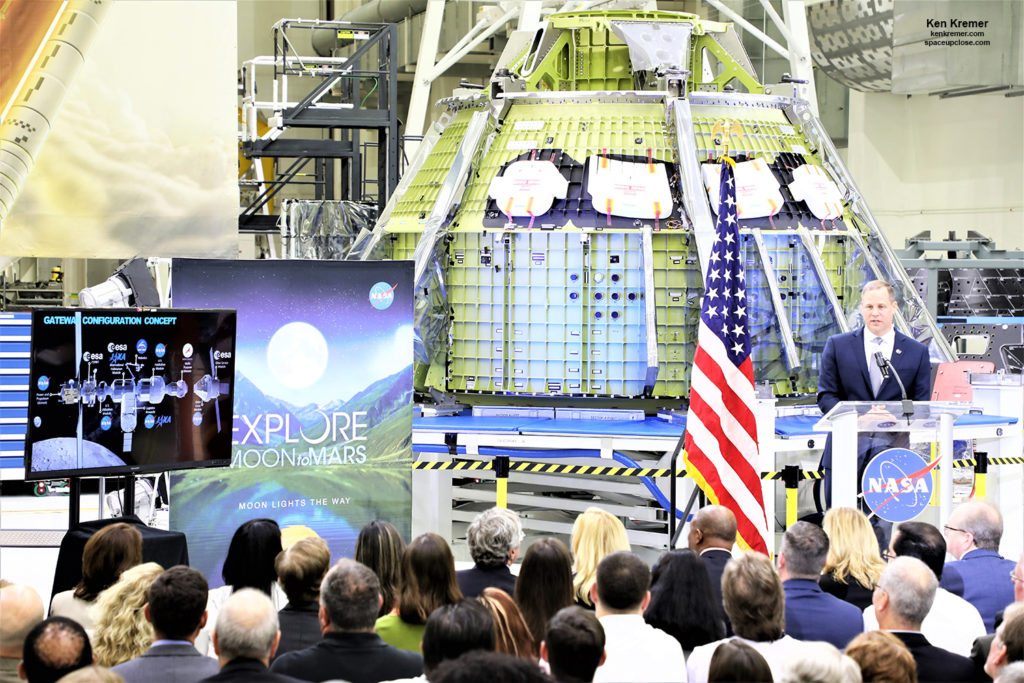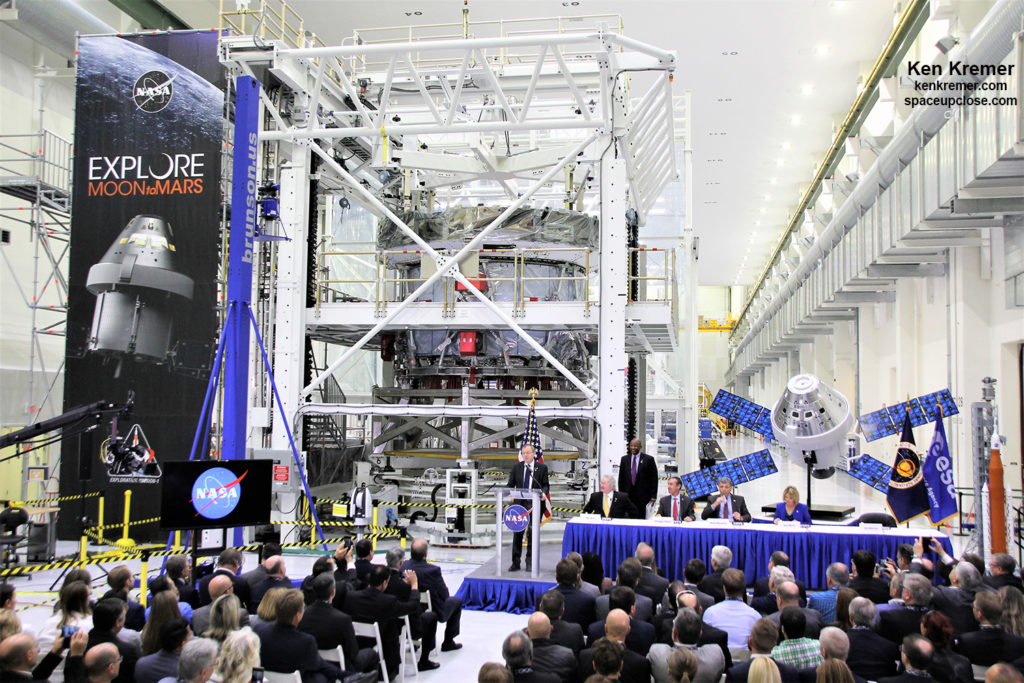Ken Kremer — SpaceUpClose.com & RocketSTEM – 26
March 2019
CAPE CANAVERAL, FL – Vice President Mike Pence called on NASA to vastlyaccelerate its human lunar spaceflight efforts and mandated the agency to adopt
“a new urgency” and ‘return humans to land on the Moon in the next 5 years’ –
meaning by 2024 – in a rousing speech at today’s fifth meeting of the National Space Council. However
he offered few technical and budgetary details on how to accomplish this
exciting goal that is long overdue.
American astronauts should
step foot on the Moon “within the next 5 years” Pence emphatically
and clearly stated – moving NASA’s human landing target up by 4 years from 2028
to 2024.
To accomplish a human lunar
landing by 2024 NASA’s SLS heavy lift rocket must be accelerated to launch NASA’s
Orion crew capsule on the Exploration Mission-1 (EM-1) test flight to the Moon
and back in 2020, Pence emphasized.
Pence laid out the dramatically accelerated timeline for ‘Boots
on the Moon’ during the National Space Council meeting he chaired at the U.S. Space and Rocket
Center in Huntsville, Alabama, today, March 26, carried live on NASA
Television.
“At the direction of the
President of the United States, it is the stated policy of this administration
and the United States of America to return American astronauts to the moon
within the next five years,” Pence said.
Furthermore Pence specified
that the Moon landing would take place at the lunar South Pole where NASA
discovered huge caches of water ice that could potentially be mined for rocket
fuel and oxygen.
“To reach the moon in
the next five years we must select our destinations now,” he said.
the lunar south pole holds great scientific, economic and strategic value, but
now it’s time to commit to go there.”
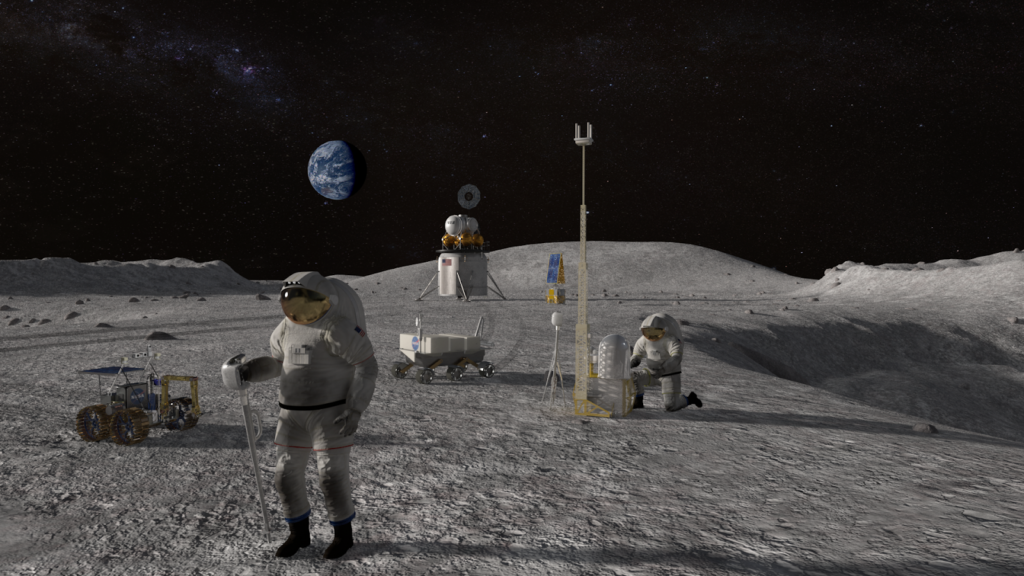 |
|
Artists concept for NASA’s human return to the Moon’s
surface by 2024. Credit: NASA |
Furthermore Pence stated that the lunar landing would
include the first woman to walk on the Moon.
“To be clear: the first woman and the next man
on the moon will both be American astronauts, launched by American rockets from
American soil.”
“It’s time to step up. Accelerate
SLS. It’s time for the Next Giant Leap’ in 5 years.”
“America will once again astonish the
world with the heights we reach, the wonders we achieve & we will lead the
world in human space exploration once again.”
The last time American astronauts
walked on the Moon was back in Dec. 1972 during NASA’s Apollo 17 moon landing
mission. No human has ventured back since.
This year marks the 50th
anniversary since Neil Armstrong became the first human to step foot on the
Moon during the Apollo 11 moon landing mission on July 20, 1969.
“That’s one small step
for man, one giant leap for mankind,” declared Apollo 11 commander Neil Armstrong,
uttering his famous first words from Tranquility Base after stepping off the
ladder of the Lunar Module named Eagle.
moon sooner a highlight of his Administration by supporting NASA and signing ‘Space
Policy Directive One’ in December 2017 which states – “the United States will
lead the return of humans to the Moon for long-term exploration and utilization,
followed by human missions to Mars and other destinations.” The budget
reality is disappointingly far different and a bit dismal.
for NASA have been insufficient for the sped up timelines and bold goals he
declared.
Indeed President Trumps’ Fiscal Year 2020 NASA
Budget request has slashed the agency’s budget by
$480 million or 2.2% compared to the actual Fiscal Year 2019 budget appropriated
and enacted by Congress in February 2019 – which amounted to $21.5 Billion.
Thus it will be up to President Trump and the
US Congress to act in a bipartisan manner and provide NASA sufficient funds to
this worthy but daunting task.
Pence stated today in no uncertain terms that the
new lunar 5 year goal would be accomplished “By any means necessary!”
directed NASA and Administrator Jim Bridenstine to accomplish this goal by any
means necessary. We must focus on the mission over the means. You must consider
every available option and platform to meet our goals.”
Pence added that commercial
alternatives would be considered if the current contractor- meaning prime
contractor Boeing for SLS- was not up to the task.
“We’re committed to Marshall. But to be clear, we’re not
committed to any one contractor. If our current contractors can’t meet this
objective, then we’ll find ones who will.”
“If commercial rockets are the only way to get American
astronauts to the moon in the next five years, then commercial rockets it will
be!” Pence warned.
“Urgency must be our watchword.”
Pence’s stern admonition to Boeing is long overdue- having
spent many Billions of Dollars since the program was approved nearly 10 years
ago and given us years of delays in return. Originally SLS was targeted for
inaugural launch in 2017.
In response NASA Administrator Jim Bridenstine accepted the challenge at the National
Space Council meeting.
“It is the right time for this challenge, and I
assured the Vice President that we, the people of NASA, are up to the challenge,”
Bridenstine replied.
“We are up to the task.”
“Anything not mandatory is a distraction,” he elaborated.
Hopefully NASA will not cannibalize science to
achieve the Moon landing because the consequences would be catastrophic for the
nation’s and NASA’s science objectives for years to come.
“Challenge
accepted. Now let’s get to work,” Bridenstine tweeted later.
The Space Launch System
(SLS) megarocket has suffered repeated delays. And Boeing informed Bridenstine
recently that they could not achieve the 2020 launch target.
Feeling the heat, Boeing
has reevaluated their prior statement of delay to NASA and promised they will achieve
the 2020 launch target.
Its not clear how this
will be accomplished – except to curtail the testing program and perhaps conduct
the first test firing of the SLS core stage on Kennedy Space Center (KSC) Launch
Complex-39B rather than a full duration “green run” test firing on a test stand at NASA’s Marshall space center.
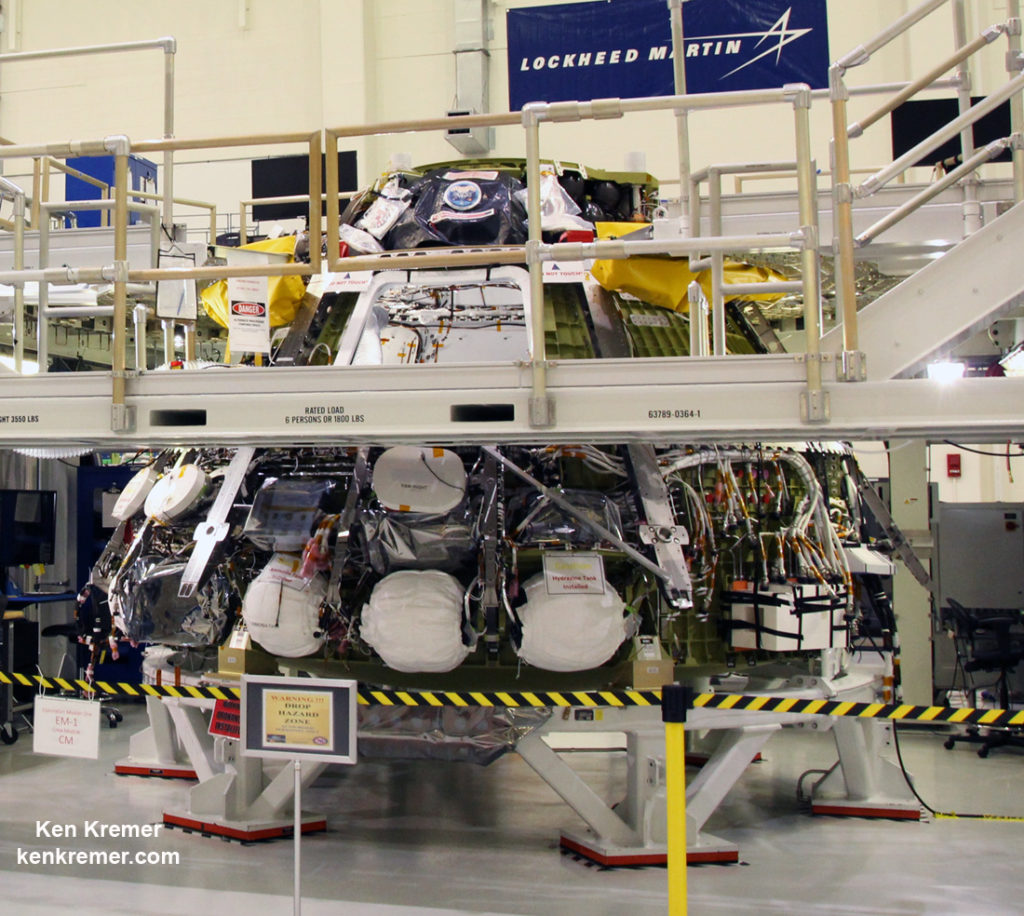 |
|
Orion EM-1 Crew Module under construction at
NASA’s Kennedy Space Center (KSC) in Florida by prime contractor Lockheed Martin. Credit: Ken Kremer/kenkremer.com/spaceupclose.com |
The commercial alternatives
to launch Orion on the EM-1 mission piecemeal on a SpaceX Falcon Heavy and ULA Delta IV
Heavy are off the table for now, Bridenstine explained.
“I did open up the window to having commercial
opportunities to launching the Orion crew capsule around the moon,” Bridenstine
stated.
“There is an opportunity there in the future. I will also
tell you that, if we want to achieve 2024, we have to have SLS. We have to
accelerate its agenda.”
NASA studied the feasibility of commercial launchers like
the SpaceX Falcon Heavy and ULA Delta IV Heavy for the past 2 weeks since Bridenstine
mentioned it during U.S. Senate testimony on March 13.
“While some of these
alternative vehicles could work, none was capable of achieving our goals to
orbit around the Moon for Exploration Mission-1 within our timeline and on
budget. The results of this two-week
study reaffirmed our commitment to the SLS.”
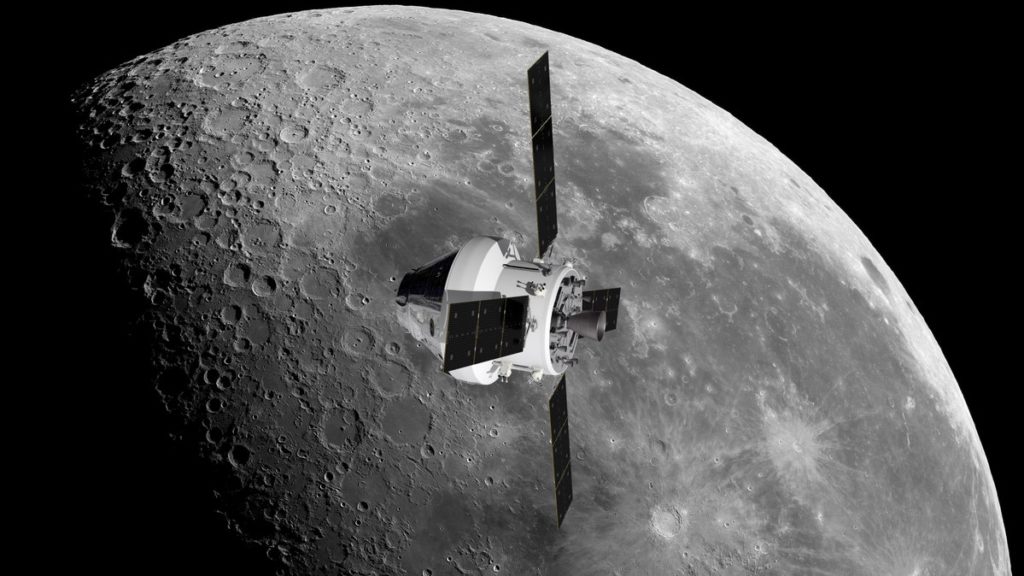 |
|
NASA’s Orion Crew Module and European Service Module
orbit around the Moon. Credit: NASA/ESA, ATG-medialab |
“This is a national priority.
We will provide the resources,” Pence said as he reminded everyone of the ever-present
competition from China and Russia.
“We must renew American
leadership in space.”
“Urgency must be our watchword.”
“The United States must remain first in
space in this century as in the last, not just to propel our economy and secure
our nation but, above all, because the rules and values of space, like every
great frontier, will be written by those who have the courage to get there
first and the commitment to stay.”
the Moon is key to NASA’s efforts – but may change after the council meeting.
Bridenstine explained that the Lunar Gateway “orbiting
around the Moon will allow us to get to more parts of the lunar surface than
ever before.”
Bridenstine also emphasized that NASA will definitely
require immediate development of the more powerful ‘Exploration Upper Stage’
(EUS) to accomplish the 2024 landing mandate.
SLS and EUS are required to launch Orion and simultaneously
co-manifested payloads to the Moon. The current ICPS upper stage for EM-1 and
EM-2 is insufficiently powered for EM-3 and beyond.
The Trump Administration had deleted all funds
to develop EUS in NASA’s recently announced FY 2020 Budget Request.
“We’re going to need an
Exploration Upper Stage, and we’re going to need that probably early, by EM-3,
the third launch of the Space Launch System.”
Thus its abundantly clear that NASA will need
much more and sustained political and monetary support from the President and
Congress to accomplish this accelerated human lunar landing timeline.
“I know NASA is ready for the challenge of
moving forward to the Moon, this time to stay.”
Bridenstine stated later that NASA would
establish a new directorate to focus on the lunar landing.
“We will take action in the days and weeks ahead
to accomplish these goals.”
“I have already directed a new alignment within
NASA to ensure we effectively support this effort, which includes establishing
a new mission directorate to focus on the formulation and execution of
exploration development activities. We are calling it the Moon to Mars Mission
Directorate.”
Vice President Pence
concluded with these words:
“Lets GO NASA. Lets GO
American space.
“Lets GO Back to the
Moon!”
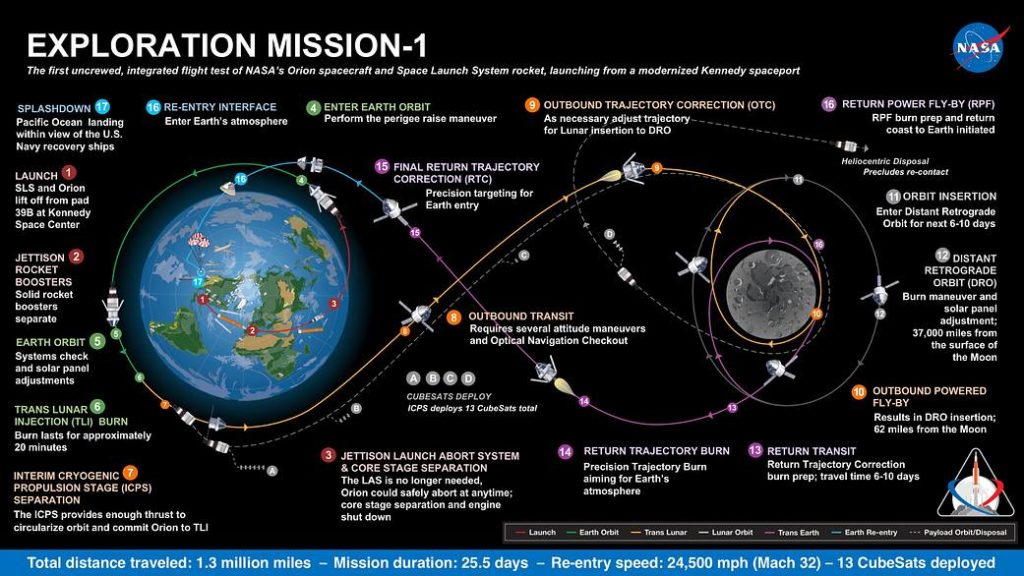 |
|
|
Here is a statement from NASA Administrator Jim
Bridenstine on the Return to the Moon in Next 5 Years:
announcement by Vice President Mike Pence, at the fifth meeting of the National
Space Council, about putting American astronauts back on the Moon in the next
five years:
“Today, I joined leaders from across the country
as Vice President Mike Pence chaired the fifth meeting of the National Space
Council. Vice President Pence lauded President Donald J. Trump’s bold vision
for space exploration and spoke to NASA’s progress on key elements to
accomplish the President’s Space Policy Directives.
“Among the many topics discussed during our
meeting at the U.S. Space and Rocket Center in Huntsville, Alabama, was to
accelerate our return to the Moon:
NASA is charged to get
American astronauts to the Moon in the next five years.
We are tasked with
landing on the Moon’s South Pole by 2024.
Stay on schedule for
flying Exploration Mission-1 with Orion on the Space Launch System (SLS) rocket
next year, and for sending the first crewed mission to the lunar vicinity by
2022.
NASA will continue to
‘use all means necessary’ to ensure mission success in moving us forward to the
Moon.
assured the Vice President that we, the people of NASA, are up to the challenge.
“We will take action in the days and weeks ahead
to accomplish these goals. We have laid out a clear plan for NASA’s exploration
campaign that cuts across three strategic areas: low-Earth orbit, the Moon, and
Mars and deeper into space.
“I have already directed a new alignment within
NASA to ensure we effectively support this effort, which includes establishing
a new mission directorate to focus on the formulation and execution of
exploration development activities. We are calling it the Moon to Mars Mission
Directorate.
“Earlier today I was also at Marshall Space
Flight Center for an all-hands to reinforce our commitment to SLS with the
workforce. We discussed my recent announcement that NASA would consider all
options to fly Orion around the Moon on schedule. I shared the analysis we
conducted to assess flying the Orion on different commercial options. While
some of these alternative vehicles could work, none was capable of achieving
our goals to orbit around the Moon for Exploration Mission-1 within our timeline
and on budget. The results of this two-week study reaffirmed our commitment to
the SLS. More details will be released in the future.
“There’s a lot of excitement about our plans and
also a lot of hard work and challenges ahead, but I know the NASA workforce and
our partners are up to it. We are now looking at creative approaches to advance
SLS manufacturing and testing to ensure Exploration Mission-1 launches in
2020. We will work to ensure we have a safe and reliable launch system
that keeps its promise to the American people.
“I know NASA is ready for the challenge of
moving forward to the Moon, this time to stay.”
………
on target to launch in mid-2020.
time launch next year.
Watch for Ken’s
continuing onsite coverage of NASA, SpaceX, ULA, Boeing, Lockheed Martin,
Northrop Grumman and more space and mission reports direct from the Kennedy
Space Center, Cape Canaveral Air Force Station, Florida and Wallops Flight
Facility, Virginia.
Stay tuned here for Ken’s continuing Earth and
Planetary science and human spaceflight news: www.kenkremer.com –www.spaceupclose.com – twitter @ken_kremer
– email: ken at kenkremer.com
Dr. Kremer is a research scientist and journalist based in the
KSC area, active in outreach and interviewed regularly on TV and radio about
space topics.
………….
Ken’s photos are for sale and he is available for lectures and outreach events
Ken’s
upcoming talks:
Apr 3:
“Exploring Mars; The Search for Life & A Journey in 3-D.” 7 PM, Lawton C
Johnson Middle School, Summit, NJ:
https://www.eventbrite.com/e/sef-grant-presents-exploring-mars-and-the-search-for-life-3d-registration-55524445110
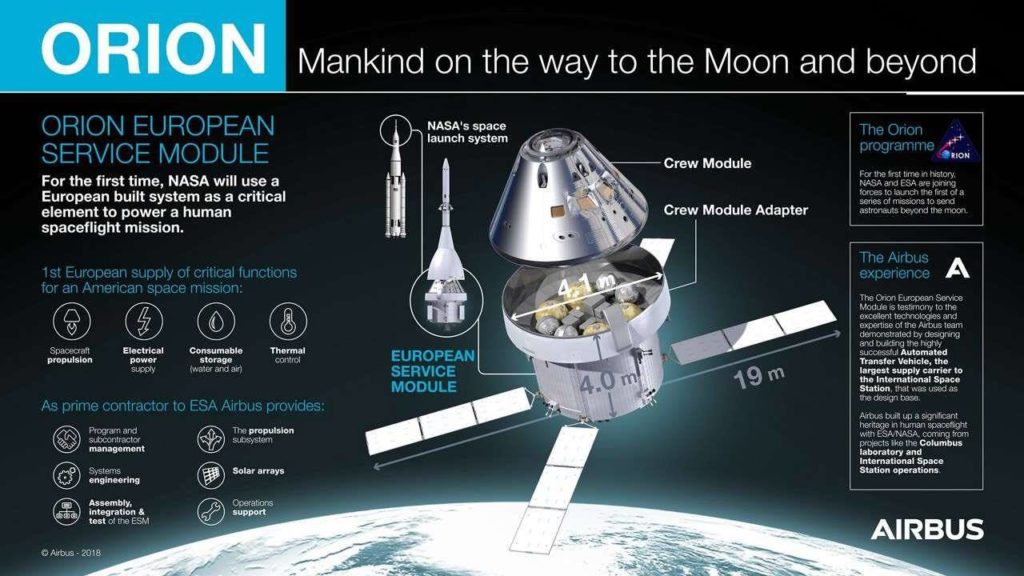 |
|
Graphic outlining European Service Module for NASA’s Exploration
Mission-1 with Orion human-rated spacecraft and Space Launch System rocket launch to the Moon in 2020. Credit: ESA/Airbus |




